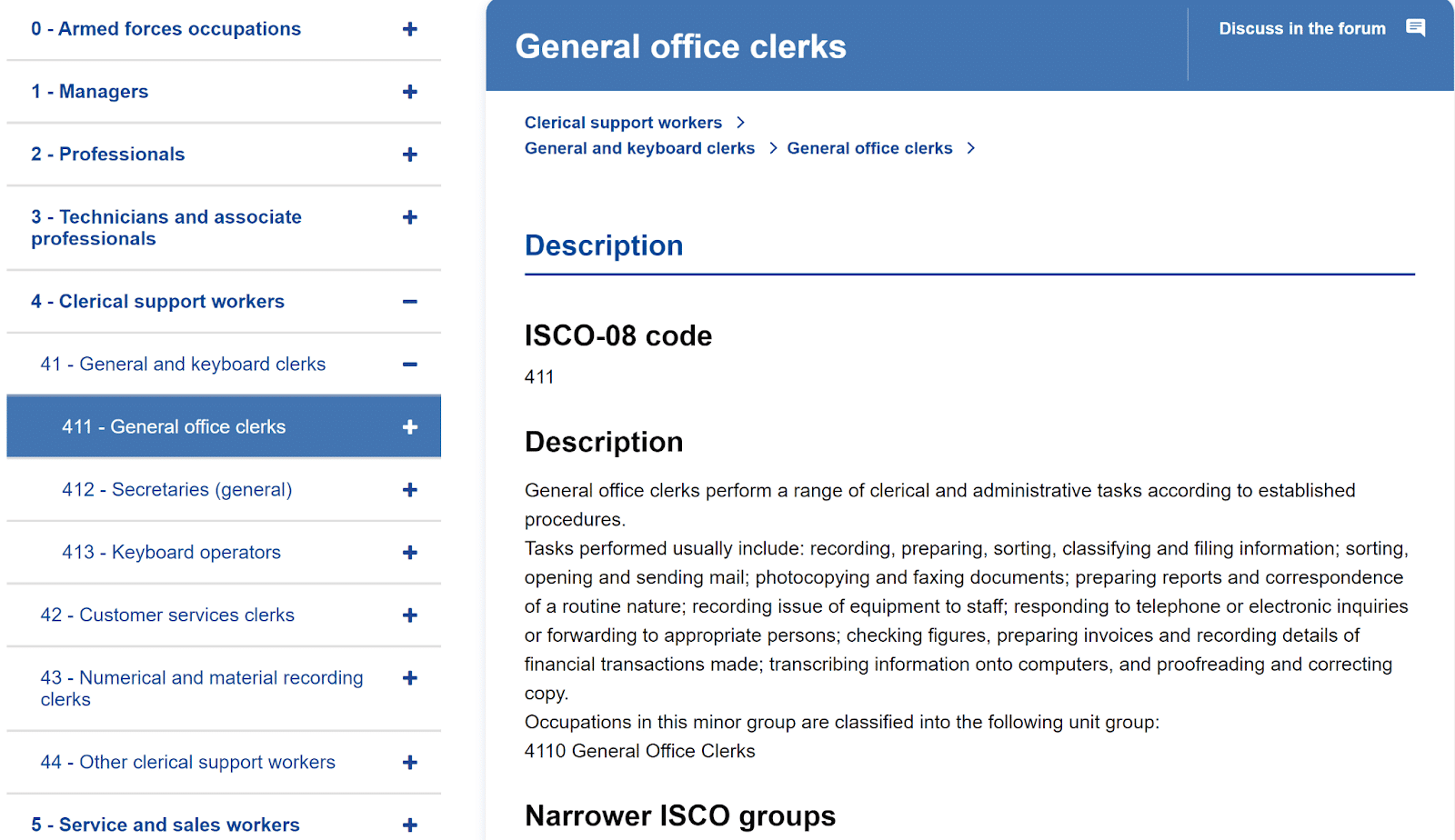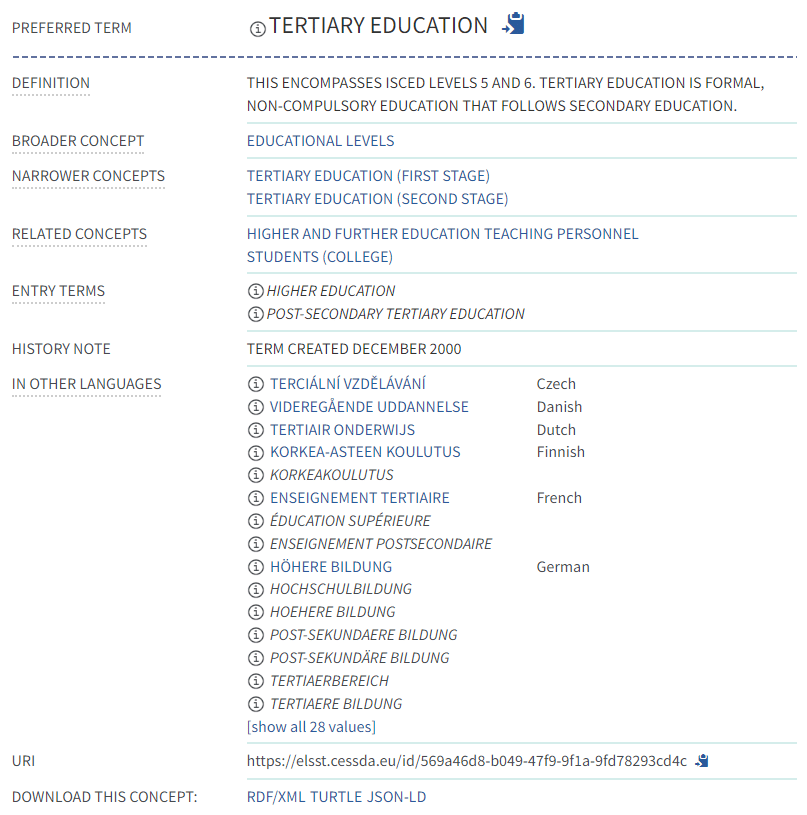Written by Angelica Maineri, ODISSEI Data Manager
Introduction
“I know what I meant to mean!”, a frustrated Gloria (Sofia Vergara’s Modern Family character, season 6, episode 7) exclaims after being mocked for misusing a figure of speech. These types of misunderstandings are common in human interactions, but most of the time they can be disambiguated, for instance by explaining a certain term, using a more widespread synonym, or describing the context in which that term is used.
There are instances in which we need to do the same with machines. For instance, in the data management landscape, the Interoperability principle (the ‘I’ in FAIR) relies on the idea that even the machine ‘understands what we mean’, i.e. the machine must be able to achieve a basic understanding of terms and concepts [1]. In this short article, I will describe some resources that are used to help humans and machines make sense of metadata: controlled vocabularies, taxonomies and thesauri. Ironically, these terms are not always used correctly, and their applications are wider than it is presented here. The aim of this short article is to provide definitions to understand their use in the context of annotating the metadata ingested into the ODISSEI Portal, a repository that combines metadata from a wide variety of research data sources into a single interface. Thanks to the annotations enabled by controlled vocabularies and related resources, the ODISSEI Portal will allow advanced semantic queries to support findability and interoperability.
Controlled vocabulary
Most of us are familiar with a vocabulary, or a collection of terms with their definitions. What are the features of a controlled vocabulary (CV) then? A controlled vocabulary – or terminology – can be defined as “a normative collection of terms, the spelling of which is fixed and for which additional information may be provided such as a definition, a set of synonyms, an editor, a version, as well as a licence determining the condition of use.” [2]. There are some important elements in this definition:
- Normative means that there are policies to establish roles and responsibilities, such as who maintains and curates the list, and how to propose changes (e.g. adding a term) (see also [3]).
- Fixing the spelling allows to reduce ambiguity and the risk of duplication [4]. Think of FAIR and fair.
- Additional information clarifies the meaning of the terms and the conditions of use. This additional information is not mandatory, but is helpful for those who want to (re)use the CV.
In their non-hierarchical form, whereby no formal relationships are specified among terms, CVs can be used to label digital resources, to facilitate retrieval of said resources, and to filter the results of a search.
Example: DDI vocabularies
The Data Documentation Initiative (DDI) is an international standard for describing the data produced in the Social, Behavioural and Economic (SBE) Sciences domain. Within the DDI alliance, many controlled vocabularies are being developed to describe the (meta)data. The CVs consist of lists of terms with their definitions. A Controlled Vocabulary Working Group is in charge of reviewing the comments, additions, and edits proposed by the community.
Take for instance the DDI Controlled Vocabulary for Mode of collection: the list represents the most common ways to collect data in the SBE sciences. It includes an unambiguous ‘Value of the Code’, but also a ‘Descriptive Term of the Code’, alongside a definition. Using such a vocabulary helps avoiding mistakes such as using ‘PAPI’ to refer to self-administered paper questionnaires.

Such controlled vocabularies are particularly useful to describe data consistently, i.e. using the same terms to describe the same feature across different datasets. However, the application of the DDI CVs extends beyond the DDI itself, since such CVs could be used, for instance, to annotate Methods sections in journal articles.
Controlled vocabularies can also be structured, which means that some sort of relationship is established among the terms in the vocabulary. In the example above, for instance, PAPI is a subclass of face-to-face interview, which is a subclass of Interview. Well-known forms of structured CVs include taxonomies and thesauri.
Taxonomy
A taxonomy is a classification scheme [5], often represented by a tree structure. Unlike an unstructured CV, which is usually sorted alphabetically, in a taxonomy terms are nested into one another. The advantage of such a structure is that you can climb ladders of the hierarchy, and group information – this is especially useful when a large number of terms is involved. For instance, a cumulative search function may be designed around a taxonomy whereby one first selects the macro category, then further specifies the subcategories. On the other hand, if the results of a search are too narrow, a taxonomy can be helpful to expand the results to a more comprehensive group.
Example: ISCO classification

The European Skills, Competences, Qualifications and Occupations (ESCO) classifications group widely known taxonomies in the Social Sciences, such as the International Standard Classification of Occupations (ISCO). ISCO is a classification of occupations, each with its own description, and organised hierarchically. For instance (see Figure 2) General office clerks constitute a subgroup of General and keyboard clerks, which in turn constitute a subgroup of Clerical support workers.
Thesaurus
A thesaurus is a structured CV in which relationships of hierarchy (“broader” “narrower”, “contains”), association (“see also”, “related to”), and equivalence (“a.k.a.”) are established among the terms representing concepts [3,6]. The hierarchical relationships help classifying (similar to a taxonomy; in fact, a thesaurus can be considered as a more complex form of taxonomy), associations allow to link concepts that are closely related, and equivalence enables to represent links such as synonyms and translations.

Example: ELSST
The European Language Social Science Thesaurus (ELSST) represents a structured list of 3000 concepts relevant for the social sciences. For each term, whose spelling is specified in the “Preferred term” field, a definition is provided to describe the meaning of the term. Furthermore, terms are organised in terms of hierarchy (“see Broader Concept”, “Narrower Concepts”), association (“see Related Concepts”), and equivalence (“see Entry terms”, “In other languages”).
The power of CVs
Now that these concepts have been clarified, it is important to understand why we need these resources.
First of all, CVs ensure consistency, which fosters interoperability. Confusion between terms such as ‘(the) Netherlands’ and ‘Holland’ (an incorrect yet widespread way to refer to the whole country), can hinder interoperability, because a machine may not understand that the same geographical area is referenced (unless otherwise specified). A solution is either to use a controlled vocabulary, and therefore pick the term – correctly spelled – from the list, or a thesaurus in which the different terms are linked through an equivalence relationship.
When relationships between concepts are specified like in a thesaurus, indexing and query recall can improve quickly. Think of a multilingual setting: when the terms used in the metadata are annotated using the thesaurus ELSST, a researcher is able to search a concept in their own language (e.g. ‘onderwijs’) and yet find relevant resources in other languages (e.g. on ‘education’).
Where to find CVs
Available registries of Controlled Vocabularies and linguistic resources include the EU’s repository of Controlled Vocabularies and the Basic Register of Thesauri, Ontologies & Classifications (BARTOC). General purpose thesauri include the English lexical database WordNet and the multilingual resource BabelNet, which also lists entities such as cities and characters.
In the social sciences, there are CVs available to annotate data descriptions (e.g. DDI vocabularies to annotate mode of data collection, sampling strategy, etc), and subjects or topic classifications (e.g. CESSDA Topic classification). The CESSDA Vocabulary Service hosts many of the DDI vocabularies and CESSDA vocabularies. As concerns concepts, which are often used to search data or literature, resources are different by field. In the psychological field, the American Psychological Association maintains a thesaurus of psychological terms (>10,000 terms); the Leibniz Information Center for Economics publishes a thesaurus for Economics (> 20,000 entries). ELSST (see above, 3,000 entries) is perhaps the most comprehensive multilingual thesaurus for the social sciences, whereas the SAGE Social Science Thesaurus lists >60,000 entries (in English) extracted from SAGE encyclopaedias and other resources.
Conclusion
In the FAIR perspective, “controlling the vocabulary helps machines and humans to categorise information and helps reduce redundancy and errors.” [4], or – in other words – to ‘understand what we mean’. To be machine-actionable, these resources need to be expressed in specific formats, and concepts have to be assigned unique IDs – these topics will be explored further in a future blog post.
Do you have comments or questions, or do you know relevant Controlled Vocabularies that should be added to the list? Let us know via fairsupport@odissei-data.nl.
Relevant links
– Guidelines on how to FAIRify vocabularies
References
[1] Jacobsen et al. (2020). FAIR Principles: Interpretations and Implementation Considerations. Data Intelligence 2 (1-2): 10–29. https://doi.org/10.1162/dint_r_00024
[2] Rocca-Serra, P. & Gray, A.G.J. (nd). FAIR Cookbook – Chapter 3 Introduction to terminologies and ontologies.
https://faircookbook.elixir-europe.org/content/recipes/interoperability/introduction-terminologies-ontologies
[3] Bowen, D. (2022). Controlled Vocabulary, Thesaurus, Ontology.
https://www.dianebowen.net/controlled-vocabulary-thesaurus-ontology.html#:~:text=For%20a%20controlled%20vocabulary%2C%20an,with%20a%20kind%20of%20taxonomy.
[4] EMBL-EBI Training (2022a). Bioinformatics for the terrified: Controlled Vocabularies.
https://www.ebi.ac.uk/training/online/courses/bioinformatics-terrified/what-makes-a-good-bioinformatics-database/controlled-vocabularies/
[5] EMBL-EBI Training (2022b). Bioinformatics for the terrified: Taxonomy.
https://www.ebi.ac.uk/training/online/courses/bioinformatics-terrified/what-makes-a-good-bioinformatics-database/controlled-vocabularies/taxonomy/
[6] EMBL-EBI Training (2022c). Bioinformatics for the terrified: Thesaurus.
https://www.ebi.ac.uk/training/online/courses/bioinformatics-terrified/what-makes-a-good-bioinformatics-database/controlled-vocabularies/thesaurus/
Photo by Edho Pratama on Unsplash
